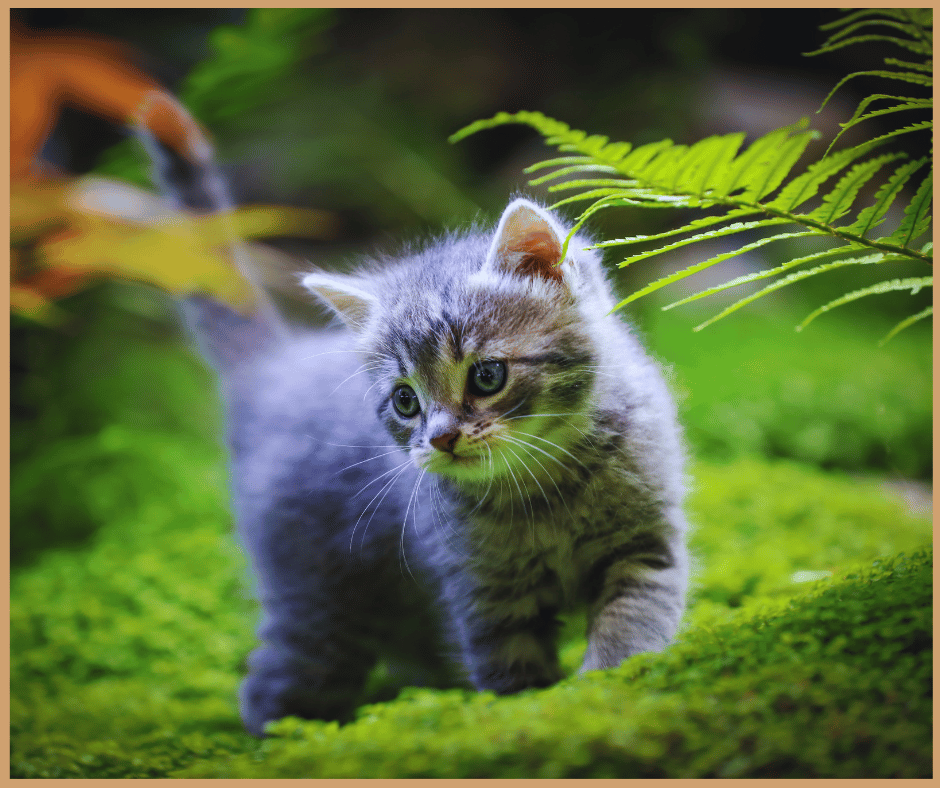Do You Know What are the top 10 most popular cat breeds in the USA? Cats hold a special place in the hearts of many Americans, loved for their sweet nature, beauty, and unique personalities.
With millions of households welcoming these furry companions, understanding different cat breeds can assist potential owners in choosing the breed that aligns best with their lifestyle and preferences.
This article showcases the top 10 most popular cat breeds in the USA, providing insights into what makes each breed unique and appealing to cat lovers nationwide.
Factors Influencing Cat Breed Popularity
Selecting the perfect cat breed entails considering different elements influencing a breed’s appeal.
Potential cat owners need to assess how compatible a breed is with their lifestyle, the breed’s behavior, health and care needs, and distinctive physical characteristics.
Grasping these aspects is essential for establishing a balanced bond between the cat and its owner, resulting in a satisfying experience of owning a pet.
Lifestyle Compatibility: Different breeds fit various lifestyles. For instance, Persians and Ragdolls are suitable for apartment living, while Bengals and Abyssinians need space and stimulation.
Temperament: Personality traits are crucial. Friendly breeds like Ragdolls and Maine Coons are popular with families, while independent breeds appeal to those needing less constant attention.
Health and Maintenance: Grooming and health needs vary. American Shorthairs are low-maintenance, while Persians require regular grooming. Awareness of breed-specific health issues is essential.
Appearance and Unique Features: Striking looks influence popularity. The Sphynx’s hairlessness, Bengal’s wild coat, and British Shorthair’s dense fur attract many, but for the best match, appearance is balanced with care needs.
1. Persian Cat
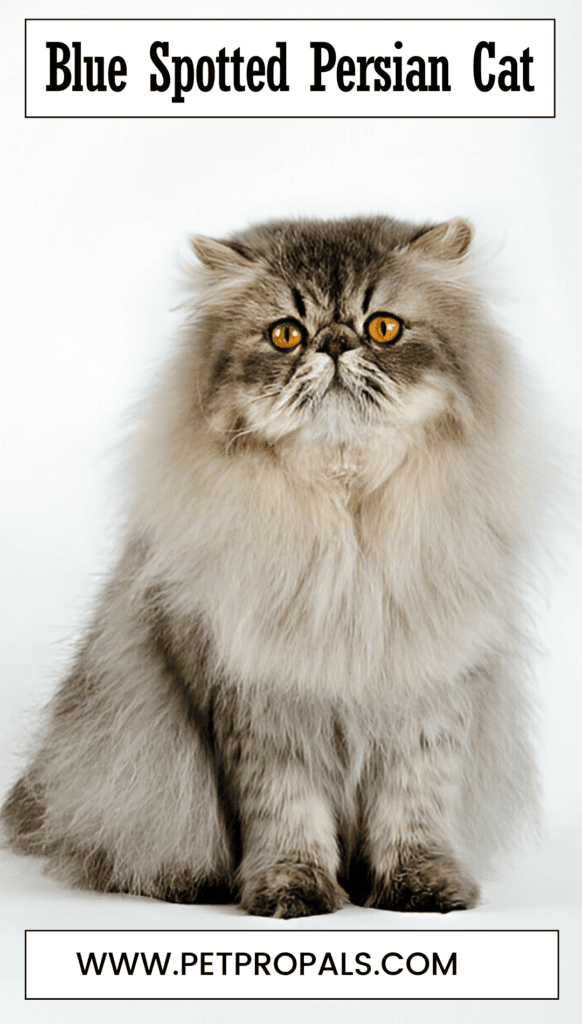
The Persian cat is one of the world’s most popular cat breeds. It is famous for its long, luxurious coats, sweet personality, and unique flat faces, making it a favorite among cat enthusiasts worldwide.
They are often seen as the perfect example of cat elegance and grace, making them a popular choice for families and people looking for a calm and loving pet.
Breed Overview
| Feature | Description |
|---|---|
| Breed Name | Persian |
| Origin | Iran (formerly Persia) |
| Size | Medium to large |
| Coat | Long, thick, and silky; many colors and patterns |
| Distinctive Features | Flat face, large round eyes, small ears, and short nose |
| Personality | Sweet, gentle, and calm |
| Interaction | Very affectionate with family, can be reserved around strangers |
| Activity Level | Low to moderate |
| Grooming Needs | Daily brushing to prevent mats and tangles |
| Exercise Needs | Low, prefers a calm environment |
| Dietary Requirements | High-quality cat food, possibly specialized diets for health issues |
| Common Health Issues | Respiratory problems, dental issues, and kidney disease |
| Life Expectancy | 12-16 years |
| Living Conditions | Best suited for indoor living, like apartments |
| Compatibility | Good with gentle children and other calm pets |
Origin
The Persian cat comes from Iran and was once called Persia. It’s been treasured for ages for its lavish fur and calm personality. Persians arrived in Europe in the 1600s. They became favorites among nobles and cat lovers for their stunning looks and gentle ways, winning hearts worldwide.
Appearance
Persian cats are medium to large and have long, thick, and silky coats in many colors and patterns. Their distinctive features include a flat face, large round eyes, small ears, and a short nose.
Personality and Temperament
Persians have a sweet, gentle, and calm personality. They are very affectionate with their family but can be reserved around strangers. Their activity level is low to moderate, and they prefer a quiet and serene environment.
Care Requirements
Persian cats require daily brushing to prevent mats and tangles in their long fur. Their exercise needs are low, and they prefer a calm environment. They should be fed high-quality cat food; some may need specialized diets due to health issues.
Health
Common health issues in Persian cats include respiratory problems, dental issues, and kidney disease. They have a life expectancy of 12-16 years.
Suitability
Persian cats are well-suited to indoor living, such as in apartments. They are friendly with gentle children and other calm pets, making them great companions for those who can care for their grooming and other needs.
2. Maine Coon Cat
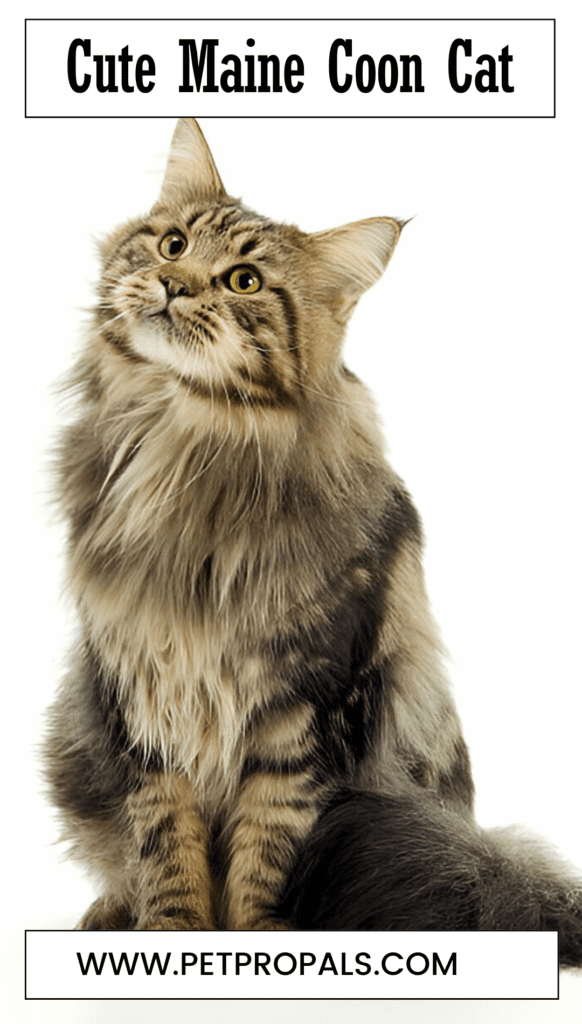
The Maine Coon cat is famous for its Large size, friendly personality, and fluffy tail, making it a top most popular cat breed and choice among cat lovers globally.
Originally from the rugged Northeastern United States, especially Maine, these cats have a rich history and are known as gentle giants because of their large size and gentle temperament.
Breed Overview
| Feature | Description |
|---|---|
| Breed Name | Maine Coon |
| Origin | United States, particularly Maine |
| Size | Large to very large |
| Coat | Long, thick, water-resistant, many colors and patterns |
| Distinctive Features | Large size, tufted ears, bushy tail |
| Personality | Friendly, outgoing, intelligent |
| Interaction | Affectionate with family, sociable with others |
| Activity Level | Moderate to high |
| Grooming Needs | Regular brushing, especially during shedding seasons |
| Exercise Needs | Moderate, enjoys interactive play |
| Dietary Requirements | High-quality cat food, moderate portions |
| Common Health Issues | Hypertrophic cardiomyopathy, hip dysplasia, spinal muscular atrophy |
| Life Expectancy | 12-15 years |
| Living Conditions | Adaptable, but prefers indoor with access to outdoor spaces |
| Compatibility | Good with children and other pets, including dogs |
Origin
The Maine Coon cat originated in the United States, specifically in Maine. They are thought to have descended from long-haired cats brought by sailors and settlers, adapting to the harsh climate and becoming prized for their hunting prowess and beloved as companions.
Appearance
Maine Coon cats are large to very large, with sturdy bodies and long, thick, water-resistant coats. They come in a variety of colors and patterns.
Their distinctive features include tufted ears, a bushy tail, and a friendly, expressive face.
Personality and Temperament
Maine Coons are loved for their friendly and pleasant personality. They’re intelligent and curious, enjoying interactive play with their owners.
They’re affectionate with their family and usually get along well with other pets and visitors.
Care Requirements
Maine Coons need regular grooming to prevent mats and tangles, especially during shedding seasons, due to their long, dense fur.
They enjoy moderate exercise and thrive on interactive toys and activities that keep them mentally stimulated and entertained.
Health
Maine Coon cats can commonly experience health issues such as hypertrophic cardiomyopathy (a heart condition), hip dysplasia, and spinal muscular atrophy.
They typically live for 12-15 years with proper care and regular veterinary visits.
Suitability
Maine Coons are adaptable to different living conditions but prefer indoor settings with access to outdoor areas.
Thanks to their friendly and tolerant nature, they are typically good with children and other pets, including dogs.
Their affectionate and playful personality makes them excellent companions for families and individuals.
3. Siamese Cat

The Siamese cat is a striking and Highly Popular Cat Breed known for its sleek body, pointed coloration, and vivid blue almond-shaped eyes.
Originating from Thailand (formerly Siam), these cats have a rich history intertwined with royalty and legend, making them one of the oldest and most popular cat breeds globally.
Breed Overview
| Feature | Description |
|---|---|
| Breed Name | Siamese |
| Origin | Thailand (formerly Siam) |
| Size | Medium |
| Coat | Short, fine, silky; color points on ears, face, paws, and tail |
| Distinctive Features | Pointed coloration, sleek body, almond-shaped blue eyes |
| Personality | Vocal, affectionate, intelligent |
| Interaction | Very social, bonds closely with family |
| Activity Level | High |
| Grooming Needs | Low maintenance, occasional brushing |
| Exercise Needs | Active, enjoys interactive play |
| Dietary Requirements | High-quality cat food, moderate portions |
| Common Health Issues | Respiratory issues, dental issues, amyloidosis |
| Life Expectancy | 12-15 years |
| Living Conditions | Adaptable, thrives in interactive households |
| Compatibility | Good with children and other pets, including dogs |
Origin
The Siamese cat originated from Thailand, which was formerly known as Siam. It was revered as sacred and kept by Siamese royalty, appearing in ancient manuscripts and artifacts dating back centuries. The cat was introduced to the Western world in the late 19th century and quickly gained popularity for its striking appearance and engaging personality.
Appearance
Siamese cats have a sleek, medium-sized body with short, delicate, and silky fur. Their unique feature is their pointed coloration and darker fur on their ears, face, paws, and tail. They have striking almond-shaped blue eyes that add to their exotic appearance.
Personality and Temperament
Siamese cats are known for their vocal nature and affectionate personality. They form strong bonds with their human companions and enjoy participating in their activities. They are intelligent and curious, often seeking out interaction and play.
Care Requirements
Siamese cats have low grooming needs, requiring occasional brushing to maintain their coat. They are active cats and benefit from interactive play and mental stimulation. A balanced diet of high-quality cat food supports their health and energy levels.
Health
Common health issues in Siamese cats include respiratory issues, dental problems, and amyloidosis (a genetic condition affecting organs). With proper care and regular veterinary check-ups, they can live healthy lives with a life expectancy of 12-15 years.
Suitability
Siamese cats adapt well to various living conditions but thrive in interactive households where they can receive attention and playtime. Due to their social and outgoing nature, they are generally good with children and other pets, including dogs. Their unique appearance and engaging personality make them cherished companions for families and individuals.
4. Ragdoll Cat
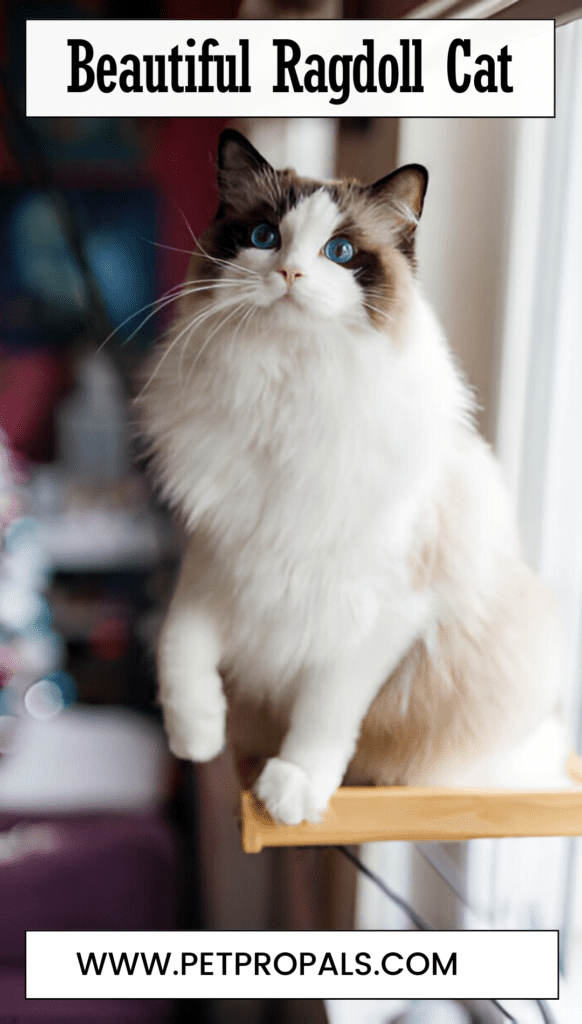
The Ragdoll cat is famous for its gentle temperament, striking blue eyes, and tendency to relax completely when picked up, which inspired its name.
Originating in the United States in the 1960s, this breed is loved for its affectionate and calm nature. This is one of the Popular Cat Breed favorites among families and individuals looking for a peaceful and loving companion.
Breed Overview
| Feature | Description |
|---|---|
| Breed Name | Blue eyes, the tendency to go limp when picked up |
| Origin | United States |
| Size | Large to very large |
| Coat | Semi-long, silky; color points on ears, face, paws, and tail |
| Distinctive Features | Adaptable, thrive in homes with companionship |
| Personality | Gentle, affectionate, relaxed |
| Interaction | Very social, enjoys human company |
| Activity Level | Moderate |
| Grooming Needs | Regular brushing to prevent mats |
| Exercise Needs | Moderate, enjoys interactive play |
| Dietary Requirements | High-quality cat food, moderate portions |
| Common Health Issues | Hypertrophic cardiomyopathy, urinary issues |
| Life Expectancy | 12-17 years |
| Living Conditions | Adaptable, thrives in homes with companionship |
| Compatibility | Good with children and other pets |
Appearance
Ragdolls are large to giant cats with semi-long, silky fur. They display color points on their ears, faces, paws, and tails, reminiscent of Siamese cats. Their most unique feature is their striking blue eyes, contributing to their serene appearance.
Personality and Temperament
Ragdoll cats are cherished for their gentle and affectionate nature. They are famous for going completely limp when picked up, which inspired their name, “Ragdoll.” They thrive on human companionship and are highly social, forming strong bonds with their family members.
Care Requirements
Ragdolls require regular grooming to prevent mats in their fur, particularly around the neck and underbelly. Ragdolls enjoy moderate exercise and thrive on interactive play sessions, which help keep them mentally and physically engaged. A balanced diet of high-quality cat food contributes to their health and well-being.
Health
Common health issues in Ragdoll cats include hypertrophic cardiomyopathy (a heart condition) and urinary problems. With proper care and regular veterinary check-ups, they can live healthy lives with a life expectancy of 12-17 years.
Suitability
Ragdoll cats adapt well to various living conditions but thrive in homes where they can receive companionship and attention. They are generally good with children and other pets, making them excellent companions for families looking for a loving and gentle cat.
5. Bengal Cat

The Bengal cat is a unique breed known for its wild appearance and playful personality.
Bengals’ coat pattern reflects their wild ancestry, originating from the crossbreeding of domestic cats with Asian Leopard Cats.
They are highly energetic and intelligent, making them a Popular Cat Breed among cat enthusiasts in the USA who are looking for an active, engaging companion.
Breed Overview
| Feature | Description |
|---|---|
| Breed Name | Bengal |
| Origin | United States |
| Size | Medium to large |
| Coat | Short to medium, dense; spotted or marbled pattern |
| Distinctive Features | Wild appearance, muscular build |
| Personality | Energetic, playful, intelligent |
| Interaction | Active, enjoys interactive play |
| Activity Level | High |
| Grooming Needs | Low maintenance, regular brushing |
| Exercise Needs | High, needs mental and physical stimulation |
| Dietary Requirements | High-quality cat food, frequent meals |
| Common Health Issues | Progressive retinal atrophy, heart disease |
| Life Expectancy | 12-16 years |
| Living Conditions | Requires space and mental stimulation |
| Compatibility | Good with children, may have issues with other cats |
Origin
The Bengal cat breed was developed in the United States during the 1960s by hybridizing domestic cats with Asian Leopard Cats. This crossbreeding primarily aimed to produce a domesticated feline with distinctive wild characteristics and a lively temperament.
Appearance
Bengal cats are medium to large with short to medium-length, dense coats. They display a spotted or marbled pattern reminiscent of their wild ancestors. Bengals are muscular and have a sleek, athletic appearance.
Personality and Temperament
Bengal cats are highly energetic and intelligent. They are known for their playful nature and enjoy interactive play sessions with their owners. They are curious and may exhibit behaviors typical of their wild ancestors, such as climbing and exploring.
Care Requirements
Bengal cats have low grooming needs and require regular brushing to maintain their coat. They have high energy levels and need mental and physical stimulation through toys, puzzles, and interactive play. A balanced diet of high-quality cat food supports their active lifestyle.
Health
Bengal cats have common health issues, including progressive retinal atrophy (a degenerative eye condition) and heart disease. With proper care and regular veterinary check-ups, they can live healthy lives with a life expectancy of 12-16 years.
Suitability
Bengal cats are best suited for active households that can provide them with space to roam and play. They are generally good with children but may have dominance issues with other cats, requiring careful introduction and supervision.
6. Sphynx Cat
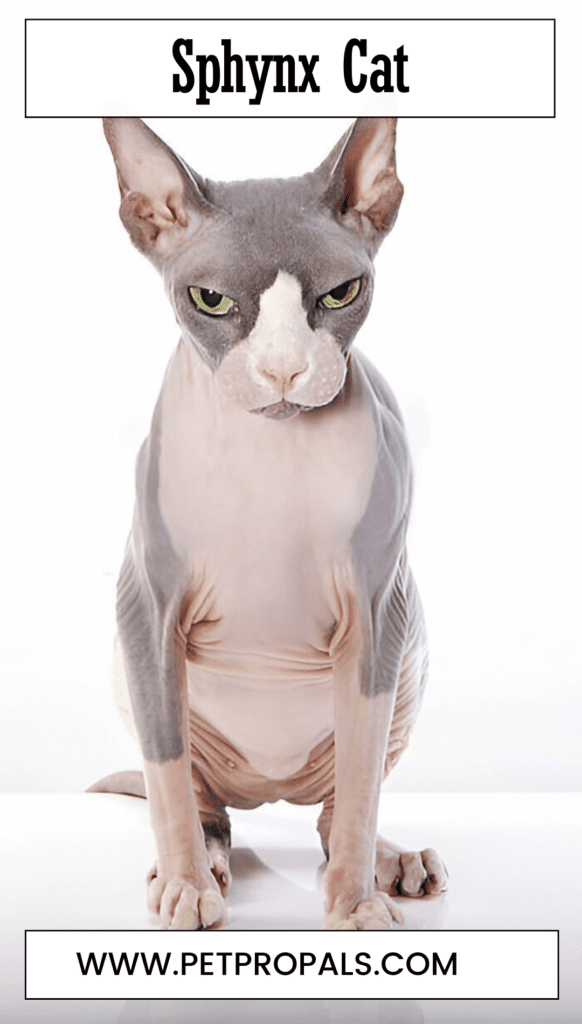
The Sphynx cat is known for its unique and striking appearance. Its lack of fur, prominent ears, and wrinkled skin make it one of the most popular cat breeds and easily identifiable.
Originating in Canada in the 1960s through selective breeding, Sphynx cats are known for their friendly and affectionate nature despite their unconventional appearance.
Breed Overview
| Feature | Description |
|---|---|
| Breed Name | Sphynx |
| Origin | Canada |
| Size | Medium to large |
| Coat | Hairless, with wrinkled skin |
| Distinctive Features | Large ears, prominent cheekbones |
| Personality | Affectionate, friendly, curious |
| Interaction | Very social, enjoys human company |
| Activity Level | Moderate to high |
| Grooming Needs | Requires regular skin care, bathing |
| Exercise Needs | Moderate, enjoys climbing and playing |
| Dietary Requirements | High-quality cat food, frequent meals |
| Common Health Issues | Skin issues, respiratory problems |
| Life Expectancy | 12-15 years |
| Living Conditions | Adaptable, thrives in interactive households |
| Compatibility | Good with children and other pets |
Origin
The Sphynx cat breed originated in Canada in the 1960s through selective breeding programs aimed at creating a hairless cat with a friendly temperament. Despite their lack of fur, Sphynx cats are known for their warmth and affection towards their owners.
Appearance
Sphynx cats are medium to large, with hairless bodies and wrinkled skin. They have large ears, prominent cheekbones, and a muscular build. Despite their lack of fur, they require regular skincare and occasional bathing to maintain their skin’s health.
Personality and Temperament
Sphynx cats are affectionate and friendly. They are highly social and enjoy human company, often seeking out interaction with their owners. They are curious and playful, enjoying climbing and exploring their surroundings.
Care Requirements
Due to their hairless coat, Sphynx cats require regular skin care to prevent oil buildup and sunburn. They enjoy moderate exercise and benefit from interactive play sessions and climbing structures. A balanced diet of high-quality cat food supports their health and energy levels.
Health
Common health issues in Sphynx cats include skin issues such as dermatitis and respiratory problems. With proper care and regular veterinary check-ups, they can live healthy lives with a life expectancy of 12-15 years.
Suitability
Sphynx cats adapt well to various living conditions but thrive in interactive households where they can receive attention and playtime.
They are generally good with children and other pets, making them excellent companions for families seeking a unique and affectionate cat.
7. British Shorthair Cat
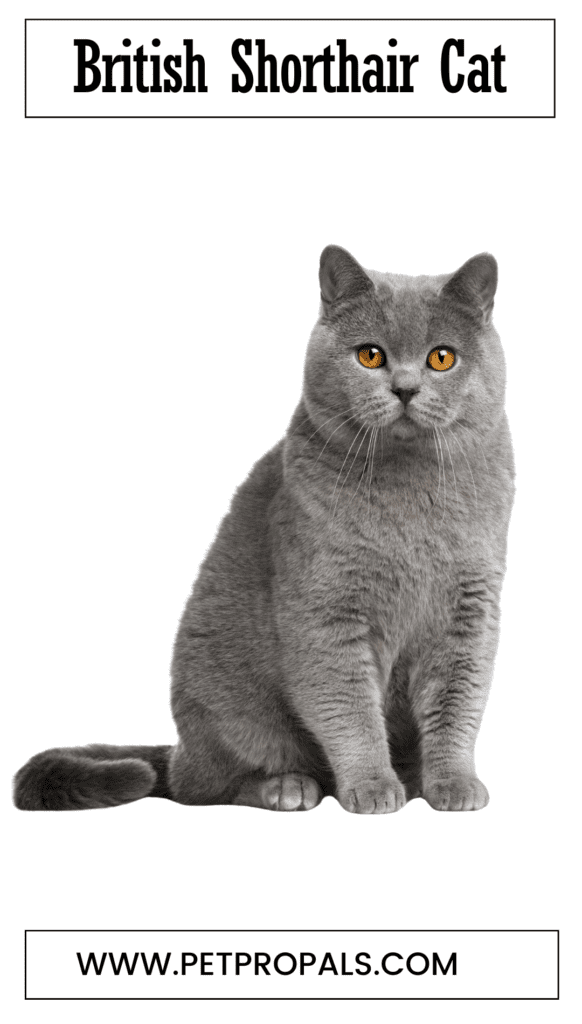
The British Shorthair cat is known for its robust build, dense coat, and round face, giving it an unusual teddy bear-like appearance.
Originating in the United Kingdom, these cats have a long history dating back to ancient times, when they were prized for their hunting skills and affectionate nature.
Breed Overview
| Feature | Description |
|---|---|
| Breed Name | British Shorthair |
| Origin | United Kingdom |
| Size | Medium to large |
| Coat | Short, dense, plush |
| Distinctive Features | Round face, sturdy build |
| Personality | Calm, easygoing, affectionate |
| Interaction | Relaxed, enjoys companionship |
| Activity Level | Moderate |
| Grooming Needs | Regular brushing, especially during shedding seasons |
| Exercise Needs | Moderate, enjoys indoor play |
| Dietary Requirements | High-quality cat food, moderate portions |
| Common Health Issues | Hypertrophic cardiomyopathy, obesity |
| Life Expectancy | 12-20 years |
| Living Conditions | Adaptable, prefers indoor environments |
| Compatibility | Good with children and other pets |
Origin
The British Shorthair cat originated in the United Kingdom, where its history can be traced back to ancient times. Initially prized for its skill in hunting and protecting food stores from rodents, it later became cherished as a companion for its calm demeanor and affectionate nature.
Appearance
British Shorthairs are medium to large-sized cats with a robust build and round face. They have short, dense, plush coats in various colors and patterns. Their distinctive features include round eyes and a sturdy, well-balanced body structure.
Personality and Temperament
British Shorthairs are recognized for their calm and easygoing temperament. They are affectionate towards their owners and enjoy companionship without overly demanding attention. They prefer a relaxed environment and are content to observe their surroundings from a comfortable spot.
Care Requirements
British Shorthairs have moderate grooming needs, requiring regular brushing to prevent matting, especially during shedding seasons. They enjoy moderate exercise and benefit from interactive play sessions indoors. A balanced diet of high-quality cat food helps maintain their health and weight.
Health
Common health issues in British Shorthair cats include hypertrophic cardiomyopathy (a heart condition) and obesity. With proper care and regular veterinary check-ups, they can live healthy lives with a life expectancy ranging from 12 to 20 years.
Suitability
British Shorthairs adapt well to various living conditions but thrive indoors where they feel secure and comfortable. They are typically good with children and other pets, making them excellent companions for families seeking a gentle and affectionate cat.
8. Abyssinian Cat
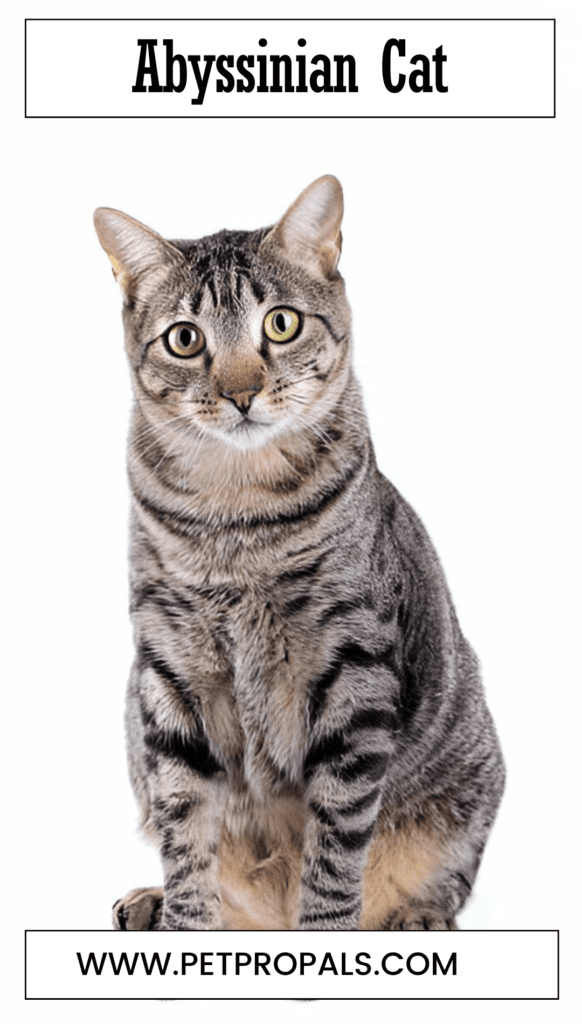
The Abyssinian cat is an ancient breed known for its sleek and muscular build, unusual ticked coat, and playful personality.
Originating from the regions around the Indian Ocean and possibly Abyssinia (modern-day Ethiopia), these cats are prized for their intelligence, agility, and lively nature.
Breed Overview
| Feature | Description |
|---|---|
| Breed Name | Abyssinian |
| Origin | Regions around the Indian Ocean, possibly Abyssinia (Ethiopia) |
| Size | Medium |
| Coat | Short, ticked (agouti) coat pattern |
| Distinctive Features | Muscular build, large ears, almond-shaped eyes |
| Personality | Active, playful, intelligent |
| Interaction | Enjoys human company, bonds closely with family |
| Activity Level | High |
| Grooming Needs | Low maintenance, occasional brushing |
| Exercise Needs | High, needs regular play and activity |
| Dietary Requirements | High-quality cat food, frequent meals |
| Common Health Issues | Periodontal disease, renal amyloidosis |
| Life Expectancy | 12-15 years |
| Living Conditions | Adaptable, requires mental stimulation |
| Compatibility | Good with children and other pets |
Origin
The Abyssinian cat’s exact origin is uncertain. Still, it is believed to have originated from regions around the Indian Ocean and possibly Abyssinia (modern-day Ethiopia). They were cherished for their agility and hunting prowess, which have persisted in the breed.
Appearance
Abyssinian cats are medium-sized with a sleek and muscular build. They have short coats with a distinctive ticked (agouti) pattern, where each hair has alternating bands of color. They have large ears, almond-shaped eyes, and an alert expression.
Personality and Temperament
Abyssinian cats are active and playful, often described as having a “wild” appearance due to their athletic build and agile movements. They are intelligent and enjoy interactive play with their owners. Abyssinians form strong bonds with their family members and thrive on companionship.
Care Requirements
Abyssinians require minimal grooming, except occasional brushing to remove loose hair and keep their coats shiny. They are highly energetic and need regular play and mental stimulation to avoid boredom. A balanced diet of high-quality cat food supports their active lifestyle.
Health
Common health issues in Abyssinian cats include periodontal disease (dental issues) and renal amyloidosis (a kidney condition). With proper care and regular veterinary check-ups, they can live healthy lives with a life expectancy of 12-15 years.
Suitability
Abyssinian cats adapt well to different living conditions but thrive in homes where they can receive mental stimulation and participate in interactive play. They are usually good with children and other pets, making them ideal companions for active families seeking an intelligent and playful cat.
9. American Shorthair Cat
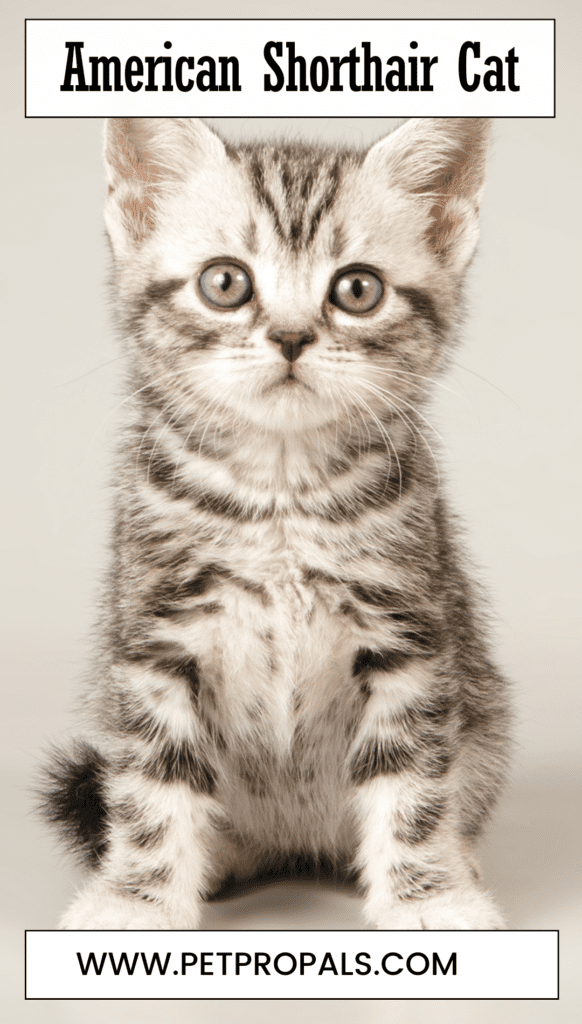
The American Shorthair cat is a sturdy and adaptable breed known for its friendly disposition, robust health, and diverse coat patterns.
Originating in the United States, these cats have a long history dating back to the arrival of early settlers, who valued them for their hunting skills and affectionate nature.
Breed Overview
| Feature | Description |
|---|---|
| Breed Name | American Shorthair |
| Origin | United States |
| Size | Medium to large |
| Coat | Short, dense, various colors and patterns |
| Distinctive Features | Sturdy build, round face |
| Personality | Friendly, adaptable, easygoing |
| Interaction | Relaxed, enjoys family companionship |
| Activity Level | Moderate |
| Grooming Needs | Low maintenance, regular brushing |
| Exercise Needs | Moderate, enjoys indoor play |
| Dietary Requirements | High-quality cat food, moderate portions |
| Common Health Issues | Hypertrophic cardiomyopathy, obesity |
| Life Expectancy | 15-20 years |
| Living Conditions | Adaptable, thrives in various environments |
| Compatibility | Good with children and other pets |
Origin
The American Shorthair cat originated in the United States, where it was brought by early settlers to control rodent populations aboard ships and in settlements. Over time, these cats became valued for their friendly temperament and adaptability to various climates.
Appearance
American Shorthairs are medium to large-sized cats with a robust build and round face. They sport short, dense coats in various colors and patterns, reflecting their diverse genetic background. They possess a well-proportioned body structure and a friendly, approachable expression.
Personality and Temperament
American Shorthairs are known for their friendly and easygoing temperament. They are adaptable to different environments and enjoy companionship with their family members. They are not overly demanding of attention but appreciate interaction and playtime.
Care Requirements
The American Shorthair needs little grooming, and it’s essential to brush them regularly to keep their coat healthy and remove loose hair.
They enjoy moderate exercise and thrive on indoor interactive play sessions. A balanced diet of high-quality cat food supports their overall health and longevity.
Health
Common health issues in American Shorthair cats include hypertrophic cardiomyopathy (a heart condition) and obesity. By taking good care of themselves and regularly visiting the vet, American Shorthairs can live healthy lives, typically between 15 and 20 years.
Suitability
The American Shorthair can adjust to different living situations. It does well in households where it can enjoy company and affection. It is generally good with children and other pets, making it an excellent companion for families seeking a friendly and adaptable cat.
10. Scottish Fold Cat
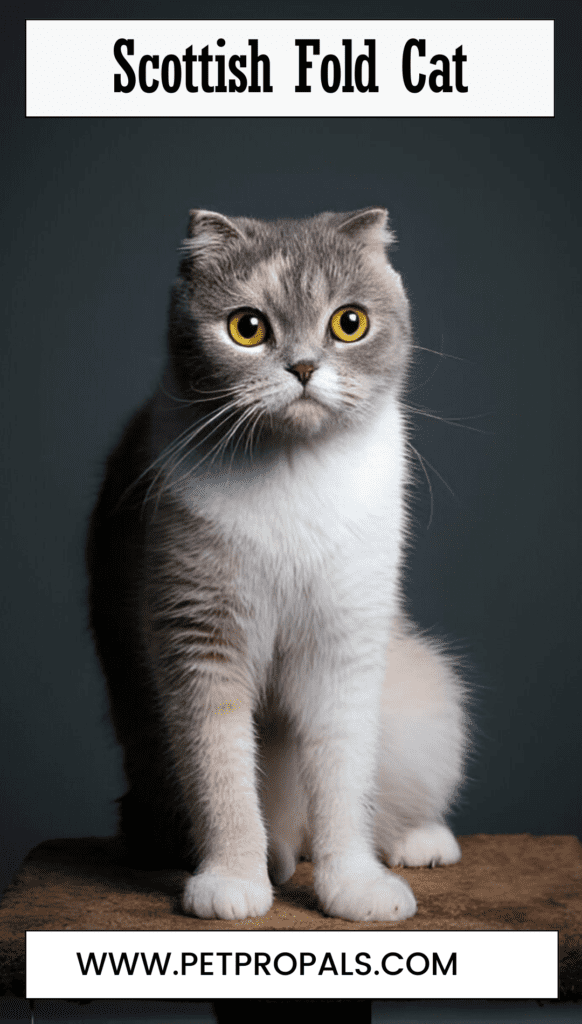
The Scottish Fold cat is easily recognizable by its unique folded ears, round face, and sweet disposition.
These felines have a fascinating history, originating in Scotland in the 1960s due to a spontaneous genetic mutation.
Known for their charming appearance and gentle demeanor, they have won the affection of cat lovers around the globe.
Breed Overview
| Feature | Description |
|---|---|
| Breed Name | Scottish Fold |
| Origin | Scotland |
| Size | Medium |
| Coat | Short to long, dense; various colors and patterns |
| Distinctive Features | Folded ears, round face |
| Personality | Affectionate, gentle, adaptable |
| Interaction | Enjoys human company, bonds closely with family |
| Activity Level | Moderate |
| Grooming Needs | Regular brushing, especially for long-haired varieties |
| Exercise Needs | Moderate, enjoys interactive play |
| Dietary Requirements | High-quality cat food, moderate portions |
| Common Health Issues | Osteochondrodysplasia (related to ear cartilage), joint issues |
| Life Expectancy | 12-15 years |
| Living Conditions | Adaptable, prefers indoor environments |
| Compatibility | Good with children and other pets |
Origin
The Scottish Fold cat was first discovered in Scotland in the 1960s due to an unexpected genetic mutation impacting cartilage development, which led to their characteristic folded ears. Their distinct appearance and calm nature contributed to their rapid rise in popularity.
Appearance
Scottish Folds are medium-sized felines with a circular countenance and bent ears that grant them an endearing and frequently inquisitive look. Their fur ranges from short to long and is dense, and due to their genetic variation, it appears in various colors and patterns.
Personality and Temperament
Scottish Folds are known for being affectionate and gentle pets. They enjoy being around people and building strong connections with their families. They can adapt to different environments but prefer indoor spaces where they feel safe and comfortable.
Care Requirements
Scottish Folds require consistent grooming to avoid tangling, particularly for long-haired types, and their grooming needs are moderate. They thrive on engaging in playtime to maintain mental stimulation and appreciate moderate physical activity. A well-rounded diet is crucial for maintaining their overall health and happiness.
Health
Scottish Fold cats commonly experience health issues such as osteochondrodysplasia, a condition linked to the ear cartilage, and joint problems resulting from their genetic predisposition. These issues can be managed with regular veterinary check-ups and proper care, and Scottish Folds typically have a life expectancy of 12-15 years.
Suitability
Scottish Folds adjust easily to indoor surroundings and flourish with their owners’ companionship and love. They usually get along well with children and other pets, which makes them great companions for families looking for an affectionate and distinctive cat.
Conclusion
The Top 10 Most Popular Cat Breeds in the USA contain various personalities, appearances, and histories, each tailored to different lifestyles and preferences.
Cats are cherished companions, prized for their loving nature, beauty, and unique quirks that captivate millions of households nationwide.
Understanding the factors influencing breed popularity, such as temperament, grooming needs, and health considerations, is crucial for prospective cat owners seeking the ideal feline companion.
Each breed, whether it’s the elegant Persian with its luxurious coat and calm demeanor, the energetic Bengal with its exotic appearance, or the affectionate Maine Coon known as the gentle giant, offers distinctive qualities that enrich the lives of its owners.
As cat lovers continue to cherish their beloved companions, the enduring popularity and admiration for these top 10 cat breeds in the USA highlight the deep bond between humans and their feline friends.
Whether you’re thinking about welcoming a new member into your family or are captivated by these remarkable creatures, delving into the world of cat breeds offers joy, discovery, and endless affection.
FAQs
What is the most popular cat in the United States?
The Domestic Shorthair takes the crown as the most popular cat in the U.S. They come in all sorts of colors and are known for being easygoing and adaptable.
What is the No. 1 cat breed?
The Ragdoll is currently the No. 1 breed in the U.S. They’re super cuddly and gentle, which makes them a favorite among cat lovers.
What is the top cat in America?
The Ragdoll cat is often seen as the top breed in America, thanks to its laid-back, affectionate personality.
What is the most American-made cat?
The American Shorthair is the most “American” cat, with a history going back to the early settlers who brought them to North America.
What is the top-selling cat?
Ragdolls are one of the top-selling cats in the U.S. because people love their soft fur and friendly, relaxed vibe.
What is the rarest cat in America?
The American Wirehair is pretty rare, with its unique curly coat making it stand out among other breeds.
What is the biggest cat breed?
The Maine Coon holds the title for the biggest domesticated cat breed. Some of these gentle giants can weigh up to 18 pounds or more!
What is the friendliest big cat?
The Siberian cat is known for being super friendly, despite its larger size. They’re affectionate and love spending time with their families.
What is the cutest cat breed?
Many would say the Persian cat is the cutest, with its fluffy coat and adorable, squishy face.
Which cat breed is most loyal?
Abyssinian Cats are known for their loyalty. They form deep bonds with their owners and love being involved in everything you do.
What is the number 1 biggest cat?
The Liger, a cross between a male lion and a female tiger, is the biggest cat in the world—some can grow over 900 pounds!
Which is the king of cats?
The lion is often called the “king of cats” because of its majestic appearance and role as a top predator in the wild.
Which cat is the strongest?
Tigers are the strongest of all the wild cats. They’re powerful hunters and can take down large prey with ease.
What is the number 1 cutest cat in the world?
The Scottish Fold, with its round face and folded ears, is often considered one of the cutest cat breeds in the world.

